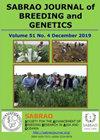基于铁锌的玉米基因型遗传多样性评价
IF 1.7
Q3 PLANT SCIENCES
引用次数: 0
摘要
隐性饥饿是当今时代最重要的挑战之一,而基因生物强化是为社区提供均衡饮食的最可行、最便宜和可持续的方式。鉴于生物强化在粮食中的价值,相关研究试图筛选玉米自交系的籽粒铁和锌含量,并利用摩尔比估计它们的生物利用度。在2018年春季种植的100个玉米自交系土壤中含有最佳水平的铁和锌。玉米基因型评价包括株高、抽雄天数、出丝天数、成熟度、穗轴长度、每穗轴行数、每行粒数、每穗轴粒数、百粒重、单株粒产量、籽粒铁、锌和植酸含量。所有被研究的性状都出现了显著差异。相关研究结果表明,籽粒铁、锌含量与植酸和籽粒产量呈显著负相关,铁、锌含量与植酸和籽粒产量呈显著负相关。籽粒产量与每穗轴行数、每行粒数和每穗轴粒数呈显著正相关。通过聚类分析和主成分分析,计算PA/Fe和PA/Zn的摩尔比来估计矿物的生物利用度。基于籽粒产量、铁、锌和PA含量的遗传变异,得到4个聚类,其中前2个聚类特征值大于1,占总方差的76.91%。基因型M-11、M-41、M-45、M-56、M-60、M-61、M-66、M-80、M-96和M-98表现出高铁和锌含量和低摩尔比,具有进一步培育生物强化玉米杂交品种的潜力。本文章由计算机程序翻译,如有差异,请以英文原文为准。
IRON-ZINC BASED GENETIC DIVERSITY ASSESSMENT IN MAIZE (ZEA MAYS L.) GENOTYPES
Hidden hunger is one of the most important challenges of the current era, and genetic biofortification is the most feasible, cheapest, and sustainable way to provide a balanced diet to the community. Given the value of biofortification in food grains, the relevant study sought to screen maize inbred lines for kernel Fe and Zn contents and estimate their bioavailability using molar ratios. One hundred maize inbred lines planted during spring 2018 in soil contained optimal levels of Fe and Zn. Maize genotypes evaluation comprised plant height, days to tasseling, silking, maturity, cob length, number of rows per cob, grains per row, grains per cob, 100-grain weight, grain yield per plant, grain Fe, Zn, and phytic acid contents. Significant differences emerged for all the studied traits. The results of the correlation study indicated that grain Fe and Zn contents had a positive genetic link with each other while a non-significant negative association with phytic acid and grain yield. A substantial positive correlation of grain yield occurred with rows per cob, grains per row, and grains per cob. Cluster and principal component analyses ran through, with PA/Fe and PA/Zn molar ratios calculated to estimate the mineral bioavailability. Based on the genetic variability for grain yield, Fe, Zn, and PA contents, four clusters resulted, and the first two PCs had an eigenvalue of more than one and depicted 76.91% of the total variance. Genotypes M-11, M-41, M-45, M-56, M-60, M-61, M-66, M-80, M-96, and M-98 showed high Fe and Zn contents with low molar ratios and are potential to benefit further breeding programs to develop biofortified maize hybrids.
求助全文
通过发布文献求助,成功后即可免费获取论文全文。
去求助
来源期刊

Sabrao Journal of Breeding and Genetics
农林科学-奶制品与动物科学
CiteScore
1.90
自引率
50.00%
发文量
63
期刊介绍:
The SABRAO Journal of Breeding and Genetics is an international journal of plant breeding and genetics research and was first published in 1969. It is the official publication of the Society for the Advancement of Breeding Research in Asia and Oceania (SABRAO).
Its objectives are to: promote the international exchange of research information on plant breeding and genetics, by describing new research findings, or ideas of a basic or practical nature; and be a medium for the exchange of ideas and news regarding members of the Society.
The Journal gives priority to articles that are of direct relevance to plant breeders and with emphasis on the Asian region. Invited for publication are research articles, short communications, methods, reviews, commentaries, and opinion articles. Scientific contributions are refereed and edited to international standards.
The journal publishes articles for SABRAO members mainly. The Journal preferred strongly that at least one author should be a current member of the Society. Non-members may also publish in the journal.
 求助内容:
求助内容: 应助结果提醒方式:
应助结果提醒方式:


